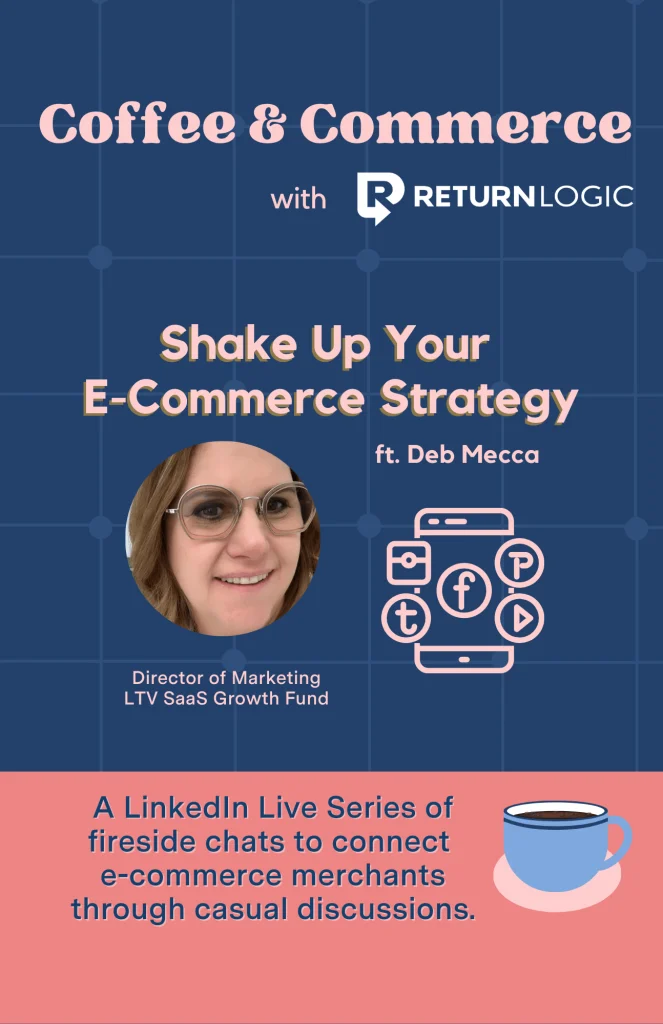Coffee + Commerce: Shake Up Your Ecomm Strategy with Social Commerce

Earlier this month, we met with Deb Mecca, for our third episode of Coffee & Commerce and chatted with her about spicing up your e-commerce strategy in 2022.
Coffee & Commerce is a series of fireside chats hosted by the ReturnLogic team to connect e-commerce storeowners together through casual discussions on LinkedIn Live. Guests include some of the best and brightest in the business—talking about what works, what doesn’t, and what’s new in e-commerce.
This episode, we discussed what e-commerce merchants can do differently in their e-commerce strategy this year to increase their brand awareness and customer retention.
Deb Mecca is a marketing expert with success in helping Shopify app partners acquire and retain customers through marketing strategy, content strategy and creation, copywriting, and digital ad creative production. She currently is the Director of Marketing for a collection of 10 Shopify apps for LTV SaaS Growth Fund.

Leveraging Social Commerce to Grow Your Brand
In our conversation with Deb, we asked her what trends e-commerce merchants should be looking out for and she said one thing stands out above all else: social commerce.
In a post-pandemic world, people aren’t just looking for quality products anymore. They’re looking to be wowed by brands. And social commerce provides a cost-efficient method to do just that while putting you directly in front of where your consumers are already hanging out.
In fact, Deb mentioned e-commerce retailers that aren’t utilizing the popular social networking app, TikTok, to gain brand awareness are losing out on a serious competitive edge.
“I think when you’re thinking about social commerce in general, it’s really tough to test out new channels that haven’t been proven or maybe … it didn’t work a year ago… [but] if you’re not taking advantage of it today as a brand, you should definitely be considering it because it’s not going away. It’s only gonna [sic] continue to grow and continue to become something of value to especially Shopify merchants.”
Deb mentions that TikTok enables Shopify catalog integrations so retailers can provide a live shopping experience directly on the app.
Virtual Shopping Experience on Social Networking Platforms
Getting started with social commerce is easy and gives your audience direct access to the people behind your business, which helps them grow loyalty to your brand. The same strategy and concept can be applied to other social platforms as well, such as Instagram.
Shopify has made it possible to integrate your store catalog directly onto all the popular social networks so shoppers can purchase your products directly from the apps they’re already spending time on.
Other platforms like Snapchat have gotten creative with creating a virtual shopping experience through augmented reality (AR) filters that allow you to try out beauty and fashion products straight from your phone.
Innovations in the social commerce world transformed shopping habits for consumers, including ordering products online that shoppers wouldn’t have expected to before.
At this point in the discussion, ReturnLogic’s E.M. Ricchini got a knock from the FedEx delivery driver at the door with her monthly box of wine, highlighting a perfect example of this. “Would you ever have thought I’d just be getting wine delivered to my house?” she asked.

Providing a New Customer Experience in E-Commerce
E-commerce retailers provide a unique experience for shoppers that can’t be replicated when buying products in-store.
For example, ordering a product online or having a monthly subscription creates a sense of anticipation while waiting for the products to arrive. This anticipation is a part of the customer journey that hasn’t existed before e-commerce retail.
“I look forward to that day every month when my wine shows up. I make the biggest deal in the world and it’s not a surprise. Like, I know exactly what’s showing up but it’s touching it, feeling it, looking through. They send me these descriptions of what everything is and [the experience] is just amazing.”
E.M. went on to mention how she’s noticed many e-commerce merchants even utilize social commerce in the post-purchase experience.
In reference to her wine subscription, she remarked how each delivery comes with tasting notes with videos and history of the wine. This is just one example of how communities are now being built around products.
This shift in the approach to the customer experience strategy gives shoppers more confidence in their purchases.
After all, live shopping on social commerce platforms allows shoppers to recommend products to each other, shop from the same places as their favorite influencers and get immediate responses to questions about the product.
Not to mention the added convenience of getting product demonstrations directly from your phone. Shoppers can experience your product in bed, on the go, or even in the bathroom.
“Customers are expecting a lot more out of the buying experience, and they will abandon your store and never come back again [if you don’t add value to how they shop].”
How to Get Started with Your Social Commerce Strategy
“It’s not a crazy amount of investment for you to make it happen,” says Deb., “It’s worth really kind of investigating how to make this happen for your store.”
But how do you actually begin to implement a strategy?
Step one, like with all things, is to map out your goals and objectives. In order to know which direction to go, you must know where you’re trying to get.
Deb explains, however, this isn’t a one-and-done type deal.
While you may have bigger overall goals and objectives that will take time, consistency, and strategy to reach, there are smaller wins you can measure on the way there to build that momentum.
The most important thing above all else, however, is to stay consistent. No matter which strategy you decide to try out first, remember to give it time to garner results before assessing whether or not you’re achieving the desired outcome.
Another thing to consider when developing your strategy is your e-commerce store’s vertical.
Fashion and beauty products such as shoes, jewelry and apparel are proven to have great success in social commerce.
If your shop falls under one of these industries, it’s important to think about your brand’s online shopping experience if you don’t want to fall behind your competitors.
When it comes to developing a strategy, it’s hard to give a formula of exactly what works. But Deb did have one nugget of insight she felt was important to share:
“I really believe that whoever is the owner of the product needs to be involved at every stage of the process because it’s their baby”
Using Shopify Apps to Enhance Your Shoppers’ Experience
We concluded our discussion with Deb with the million-dollar question: All these tips on strategy are great and all, but with over 7,000 apps on Shopify alone, how are e-commerce merchants supposed to weed out which apps are truly beneficial to their shop?
Deb mentioned that Shopify’s recent announcement of changing how they pay their partners has opened a floodgate of opportunities for app developers that are bound to close eventually, causing Shopify partners to take advantage of this time while they can.
The issue that this has created is a saturated market of apps that make it hard for e-commerce store owners to decipher what is simply a nice addition vs. an absolute necessity to the shopping experience.
Again, while there may be no formula to which apps are essential, the best practice is to utilize apps that work well together to create a seamless shopping experience.
“At the end of the day, we want to authentically recommend apps that are going to help you grow your business and having things like partnerships, webinars, and content, all that stuff is only going to help elevate those opportunities.”
Final Advice for E-Commerce Retailers
Before we ended our chat with Deb, we asked her if she has any general advice for merchants that she’d like to share. Here’s what she had to say:
“Don’t be afraid to test things out, don’t be afraid to dip your toes into the sand. If at first you don’t succeed, definitely try again. I think something that I kind of just want to leave us all with is I remember back in the day when people tried out Pinterest, and they were like, it’s not really for me. It doesn’t work for my business. And then we learned it’s actually one of the largest search engines in the world. I think the same goes for TikTok. It’s one of the largest apps in the world right now. Just spend some time there, look around, get a feel for things. The algorithm is fantastic, so don’t worry.”
So, there you have it! If you want to stand out in e-commerce today, you can’t be afraid to shake up your strategy.
If you didn’t catch the last episode of Coffee + Commerce live, don’t worry, we have the full clip available for you below.
Be sure to let us and Deb know what your biggest takeaway was from this episode and we hope you can apply what you learned about utilizing social commerce to improve your shoppers’ experience and grow your brand.





